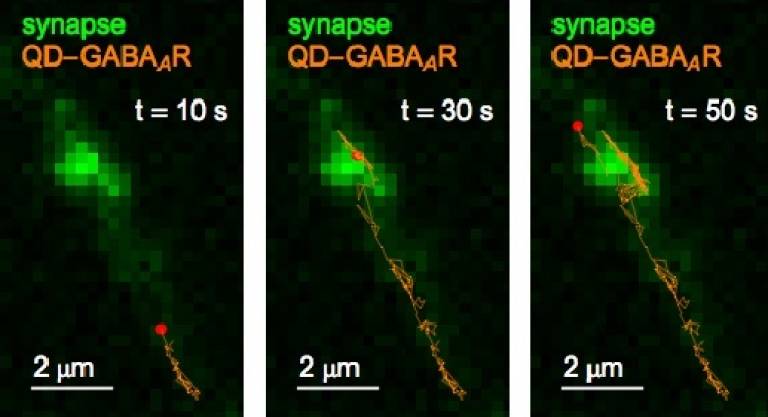Seeing single receptors at synapses with nanocrystals
9 September 2010
MRC-funded scientists led by Dr Josef Kittler (UCL Neuroscience, Physiology and Pharmacology (NPP)) have used nanometer-sized fluorescent crystals (called quantum dots) to study how the behaviour of single receptor proteins in nerve cells regulates the balance of communication in the brain.

Nerve cells send signals to each other by releasing chemicals at specialized junctions between cells, called synapses. One key neurotransmitter, GABA, acts on special proteins (GABA receptors) to generate inhibition, which stops the brain from becoming too excitable, which would lead to seizures and epilepsy. In a paper published this week in the Proceedings of the National Academy of Sciences, Dr Kittler and colleagues reveal that GABA receptors, which they visualise by quantum dot tagging, can move rapidly in and out of synapses to control the strength of inhibition, and that this can happen in response to nerve cell signals.
James Muir (UCL NPP and CoMPLEX), the first author on the study, adds: "We show that the stability of GABA receptors at synapses can be controlled by signalling through the excitatory neurotransmitter, glutamate, providing a mechanism for controlling the balance of excitation and inhibition".
In neurological disorders such as epilepsy, too much glutamate can be released from nerve cells which - through the pathway identified in this research - could cause a depletion of GABA receptors from synapses. This phenomenon could therefore make epilepsy worse by decreasing inhibition.
Lead author Dr Josef Kittler said: "In collaboration with Lewis Griffin in UCL Computer Science we have been able to develop the tools necessary to detect and analyse the behaviour of single receptors in the surface membrane. Being able to see single receptors moving in nerve cells is incredibly exciting and is a great example of how programmes like UCL's CoMPLEX bring biologists and mathematicians together to solve difficult problems in the life sciences".
The research is also a good example that shows how investigating the function of tiny, but crucial, cell components such as synapses contributes to understanding problems that affect whole body systems.
Image: The panels show diffusion of a GABA-A receptor that has
been tagged with a quantum dot. The receptor moves into and then out of an
inhibitory synapse (green). Its trajectory is plotted in orange and is shown at
the times indicated.
For more information about Dr Kittler's
research, please visit his webpage.
Current PNAS paper (subscription may be required)
 Close
Close

